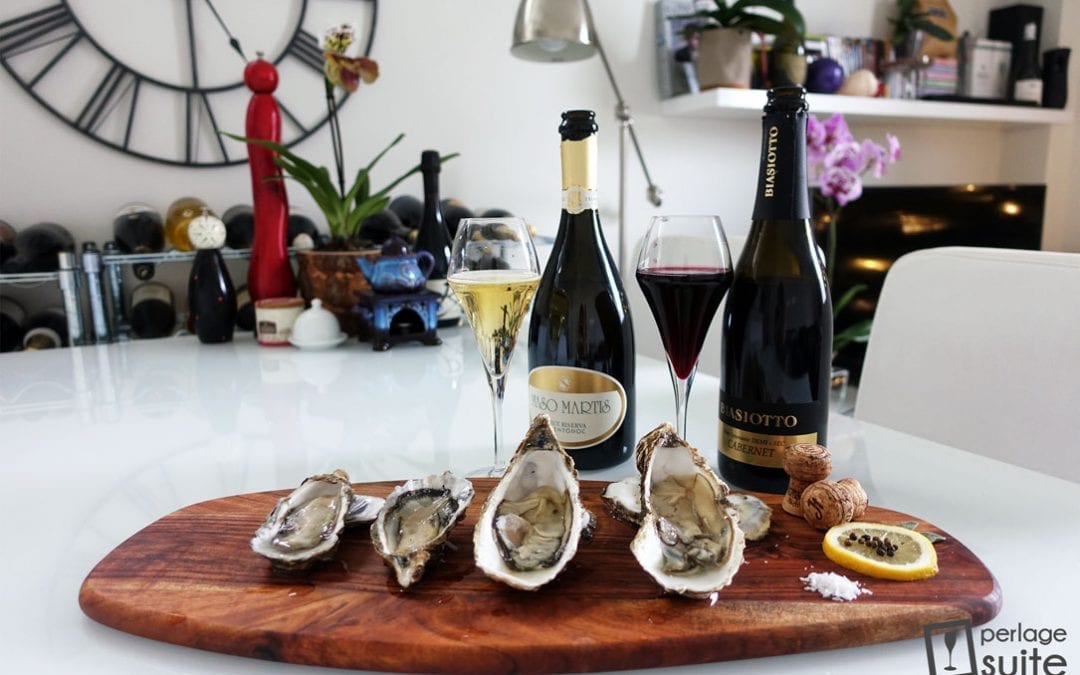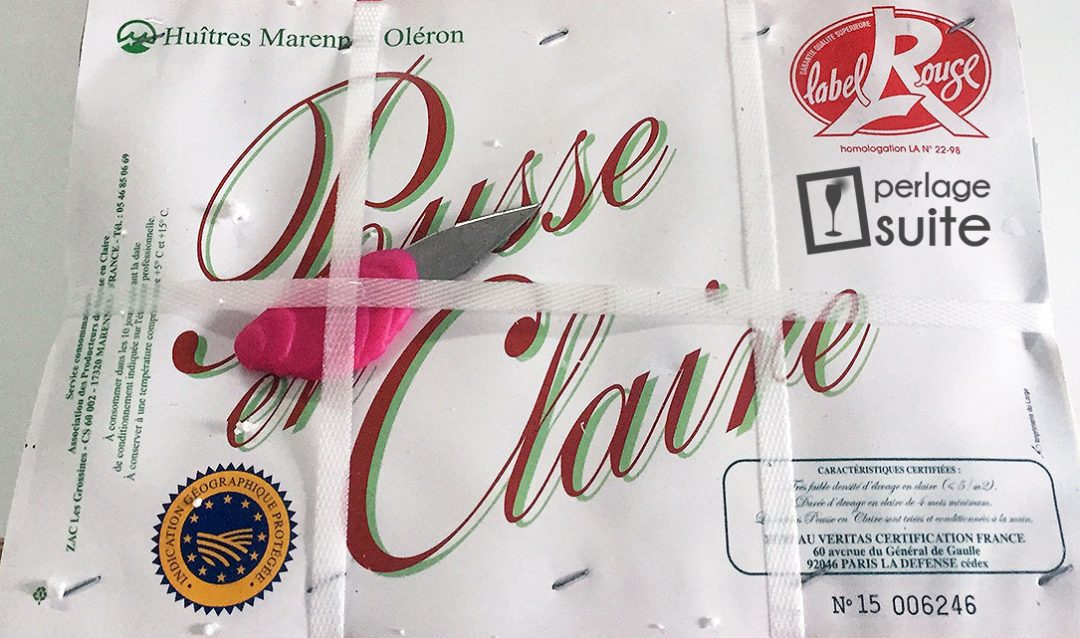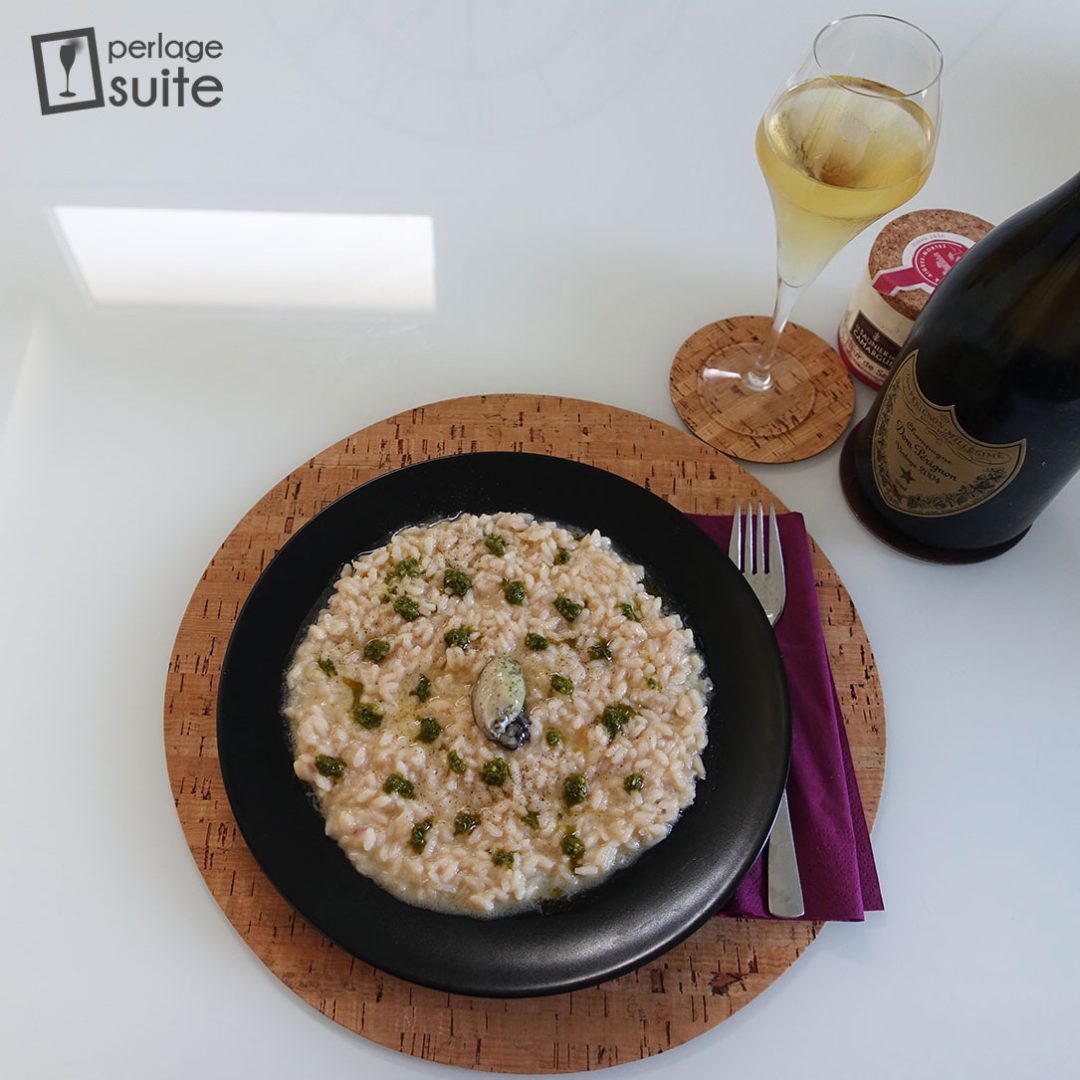Today I received a very welcome gift from the The Fish Square following my appreciation of their innovative format I Love Oyster which I discovered at GourmArte 2016. I personally love oysters, but especially I love experimenting with unconventional food and wine pairings... then I also decided to create an easy and impressive recipe by combining the oyster with Champagne Risotto and Pesto alla Genovese DOP.
This pairing comes about because the oyster I chose for the recipe after the tasting is the Pousse en Claire Label Rougesweet and not very savoury, which contrasts perfectly with the marked saltiness of Pesto alla Genovese. Furthermore, the Champagne gives an unmistakable, rounded flavour to the risotto, and goes well with the mantecatura butter. And let's face it, oysters and Champagne is a great classic, even if it is often refuted by some oeno-snobs who call it a poor pairing reserved for those who don't understand much about wine.
Allow me, as always saying Champagne does not say enough about wine, it is like saying Franciacorta. Are you trying to tell me that all wines produced in Champagne or Franciacorta are the same? It is terroirs and production areas that give us important indications, but not enough to judge a pairing as good or bad! And the same applies to the oyster as to the 'Merroir' and the various types are very different. I think there are very good Champagnes for very good oysters. For example, for this recipe, I chose the Pousse en Claire precisely because it is sweet, complex, delicate and not very salty and goes perfectly with the fresh, savoury creaminess of a Champagne such as the Lanson Black Label.
Oysters: 4 things to know before eating them
#1 oysters: how to store them?
Fresh oysters will keep in the fridge for up to a week, but in general the rule applies that the sooner you eat them the better! Put the wooden box of oysters in the coldest place, trying to touch it as little as possible. If you can, also limit the openings of the fridge! I always keep them in the original box as, in this case, the one in the picture!
Oysters #2: how to open them?

OK I admit it, when I opened the first oyster it was a trauma: I just couldn't do it and I didn't even have a glove at home so I was afraid of hurting myself. Then I understood the trick and it became really easy! To open the oyster, you have to insert the knife into the narrowest part of the valves, where there is a breaking point in the 'hinge', and pry it open until you hear a small popping noise (of the upper valve). At this point you can run the knife around the edge and gently pull the shells apart, taking care not to break the mollusc (help yourself with the knife).
#3 oysters: how to recognise fresh ones?
![]()
Open oysters are to be discarded a priori because they are already dead. Oysters that once opened do not contain much liquid and have the flesh beginning to stick to the sides of the shell have been out of the water too long. These are only to be eaten cooked. Fresh oysters are alive and, if opened correctly, will fall off the valve and have a good supply of liquid. A good tip for recognising a healthy oyster is to look at it and smell it: if it is closed properly and if the shell has a good sea scent then it is almost certainly a fresh and healthy oyster!
For example, the one I am holding in my hand in the photo was already open and therefore dead, which is why I discarded it. If you pay attention do you see that the colour is darker than the other 2 of the same species? Dead oysters have a grey colour tending to black and in the photo it is more than obvious the difference between the live oyster (good to eat) and the dead oyster (not to eat)!
Oysters #4: oyster serving temperature and tasting tips
The ideal temperature for eating oysters is between 6 and 8 °C to bring out all the organoleptic characteristics. The best way to taste the oyster is to sip the salty liquid inside and then take the oyster between the lips and chew it slowly, making sure to pass it over all the corners of the tongue to receive the different tactile sensations.
Oysters: tasting & pairing 'in purity

The tasting samples he sent me The Fish Square have two different sizes: size 0 and size 3. The gauge defines the size of the oysters and varies from 0 (the largest) to 5 (the smallest). To learn more about the cultivation, size, origin and sustainability of oysters, I recommend reading this article.
In the photo: Pousse en Claire PGI Label Rouge, size 3 (to your right), Special Bouzigues, 0-gauge (to your left).

.Pousse en Claire PGI Label Rouge oysters, size 3 with Trento DOC Brut Riserva Maso Martis (Champenoise Method)
Origin: France - Charente maritime - Marennes-Oléron
Shelf life:10-12 days
Catching method: Farmed
Scientific name : Crassostrea gigas
Season:from October to March
Approximate weight each gr 80
Calibre: 3
Some information on this type of oyster
La Pousse en Claire is an exceptional oyster and is the pride of the oyster farmers of Marennes Oléron because it can boast the prestigious Label Rouge: the red label that makes the heart of every oyster enthusiast beat faster as it is a sign of perfection. The Label Rouge is the official French recognition that guarantees the superior quality of the food products to which it is awarded. Originally, this particular oyster was produced almost in secret and only for a lucky few palates. Even today, it is produced in limited quantities (5 oysters per square metre) and therefore remains a niche oyster, reserved for a small circle of connoisseurs. While in the claires (4 to 8 months) achieves a high amount of meat and a refined taste, as refined is also the conformation of the shell with the characteristic lace called 'lignes de pousse". Already to the eye it is a compact and solid oyster, whose shell is tough and does not crumble easily.
The Terroir, or rather the 'Merroir'
The district of Marennes-Oléron is the most important oyster production site in France thanks to its optimal natural conditions for oyster farming. In the large basin in the shadow of the island of Oléron, fed with nutrients by the changing tides, there are pure waters that are ideal for growing oysters. Over the centuries, the oyster farmers of this region have been able to elevate oyster farming to an art by using the claires to refine their oysters. The claires are small concave basins dug into the clay in which the oyster completes its growth. The combination of fresh and salty water and the nature of the nutrients give rise to the differences in colour and flavour typical of this family of oysters, a bit like terroir influences wine.
Oyster-wine pairing
The Pousse en Claire oyster has a delicate, round, sweet, mineral, persistent flavour and a firm, crispy flesh. For this I chose the Trento DOC Brut Riserva by Maso Martis, an excellent Trentino-Alto Adige winery that I discovered during my bubbly-hunting trip for the Sparkling Wine Guide 500 bubbles in 500, characterised by a great softness and distinct flavour. This Champenoise method sparkling wine is made from a cuvée of Chardonnay and Pinot Noir and rests at least four years on the lees to get its full body, creamy bubbles and extraordinary persistence.
Bouzigues Special Oysters, 0-gauge with Biasiotto Cabernet Demi Sec sparkling wine (long Charmat Method)
Catching method: Farmed
Scientific name : Crassostrea gigas
Shelf life: 10-12 days
Season: October to June
Approximate weight each gr 120
Gauge: 0
Some information on this type of oyster
The Terroir, or rather the 'Merroir'
Oyster-wine pairing
This oyster is very different from the previous one, so for the wine pairing I wanted to experiment with the same contrast I found between the two oysters. I chose for this one a sparkling wine charmat method Demi sec, i.e. with an important residual sugar, perfect to contrast the marked savouriness and iodine taste of this oyster. Whereas in the previous oyster I found great complexity on the palate, this oyster has a simpler and more delicate taste, and simple and delicate had to be the wine. For this I chose a charmat method with a few aromas of ripe fruit and a light spicy note from Cabernet grapes. In short, the combination with the cabernet demi sec red sparkling wine from Biasiotto may perhaps appear to be daring too much, but when seen from the perspective of its motivations, there is a logical thread that has given me great satisfaction.
Recipe: Risotto with Champagne, drops of Pesto alla Genovese, Oyster Pousse en Claire Label Rouge IGP, Black Pepper
Oysters have always been rumoured to be an aphrodisiac (thanks to their high zinc content, which increases spermatozoa and testosterone), but another good reason to eat them (perhaps in the company of your better half to check if there is an actual increase in sexual desire) is that they have very few calories and very little fat. They are also rich in potassium, calcium, iron, phosphorus and vitamins A, B1, B2, C, E, PP. In short, they are also perfect for me who (from next Monday) am on a diet! 😀
"By pure chance, an oyster I was about to put in Emilia's mouth slipped out of its shell and fell on her breast. The girl made the gesture of picking it up with her fingers, but I prevented her, claiming the right to unbutton her bodice to pick it up with my lips at the bottom where it had fallen..."
Casanova
Personally, I think that more than increasing sexual desire, they provide a kind of fun that makes us lower our defences and relax... and one thing leads to another! 😆
TIME: 30 minutes | Difficulty: MEDIUM | Cost: HIGH
Calories: ARE YOU SURE YOU WANT TO KNOW?
Ingredients for 2 sweethearts
For Pesto alla Genovese DOP:
- 50 grams of Basil Genovese DOP
- 100 grams of Extra Virgin Olive Oil
- 75 grams of Parmigiano Reggiano aged 36 months
- 25 grams of Pecorino DOP Fiore Sardo
- 20 grams of pine nuts
- 1 clove of garlic (optional)
- a little rock salt
For the risotto:
- 250 grams of Year-old Acquerello rice
- 200 ml Champagne or Spumante Metodo Classico Brut
- 1 small Tropea onion
- 60 grams of high-quality butter
- 50 grams of Parmigiano Reggiano aged 36 months
- 2 Pousse en Claire Label Rouge PGI oysters
- a little rock salt
- Sarawak Gold' fine pepper
- vegetable stock QB (I recommend preparing at least 1 litre to make sure you have everything you need to cook the rice).
Preparation:
For Pesto alla Genovese DOP:
The traditional recipe for Pesto alla Genovese DOP requires a lot of patience and elbow grease. In fact, to prepare it, you need a mortar and to pound the various ingredients to 'crush' the basil so as to concentrate the essential oils and not grind it as in a blender.
However, we are desperate housewives, an extraordinary cross between Bridget Jones and Kate Armstrong, the very talented Chef of Tastes and Dislikes played by the beautiful Catherine Zeta-Jones, and we just can't stand to pound those little basil leaves for an hour with a mortar like this.
So my recipe is to put the glass and blender blades in the fridge an hour before starting so as to limit the oxidation damage that can occur with the heat from the blades running and blend all the ingredients together like there's no tomorrow. I don't have to remind you to wash the basil and peel the garlic, do I? 😆
For the risotto:
The Kate Armstrong in you will tell you to choose an expensive copper pot, but you are still Bridget Jones and you will choose the convenient non-stick pan... On the amount of rice per person, some say that a portion varies between 60 and 80 grams. My grandmother would have given you that amount to feel if the rice was cooked... so I'd say for two a package such as this one year-old Acquerello rice is perfect! 😍
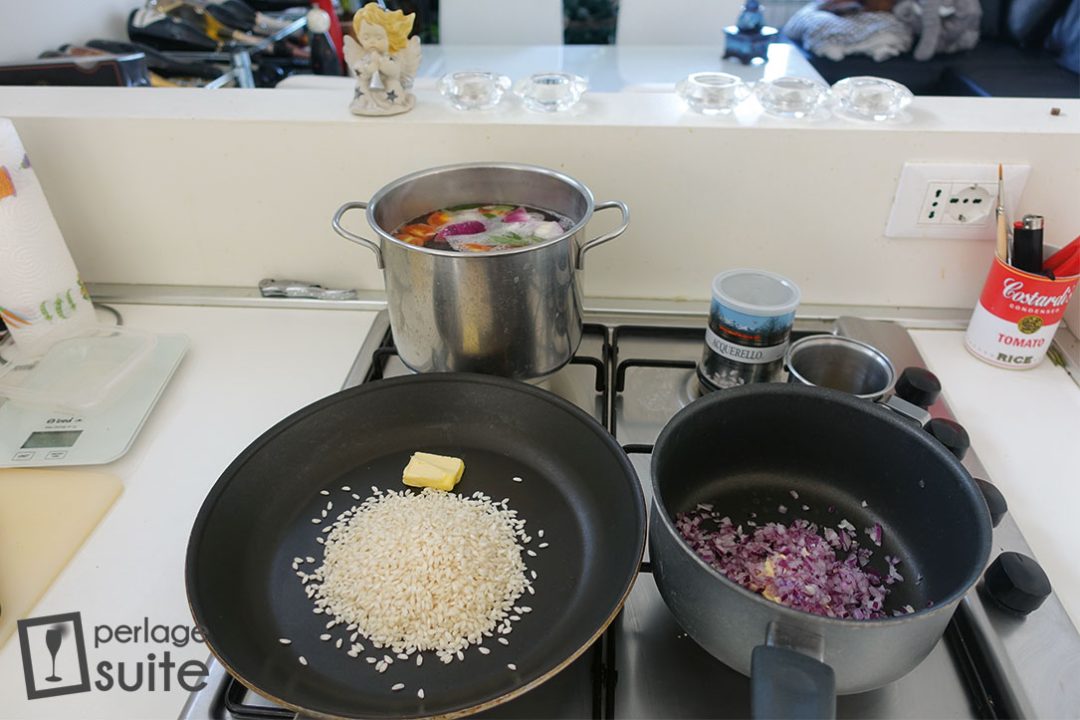
Chop the onion fine to the point that it is almost invisible when cooked and fry it with 20 grams of butter in a not too large non-stick pan. After you have chosen your risotto cooking pan (the famous non-stick pan :D) toast the rice in 20 grams of butter for a couple of minutes on high heat.
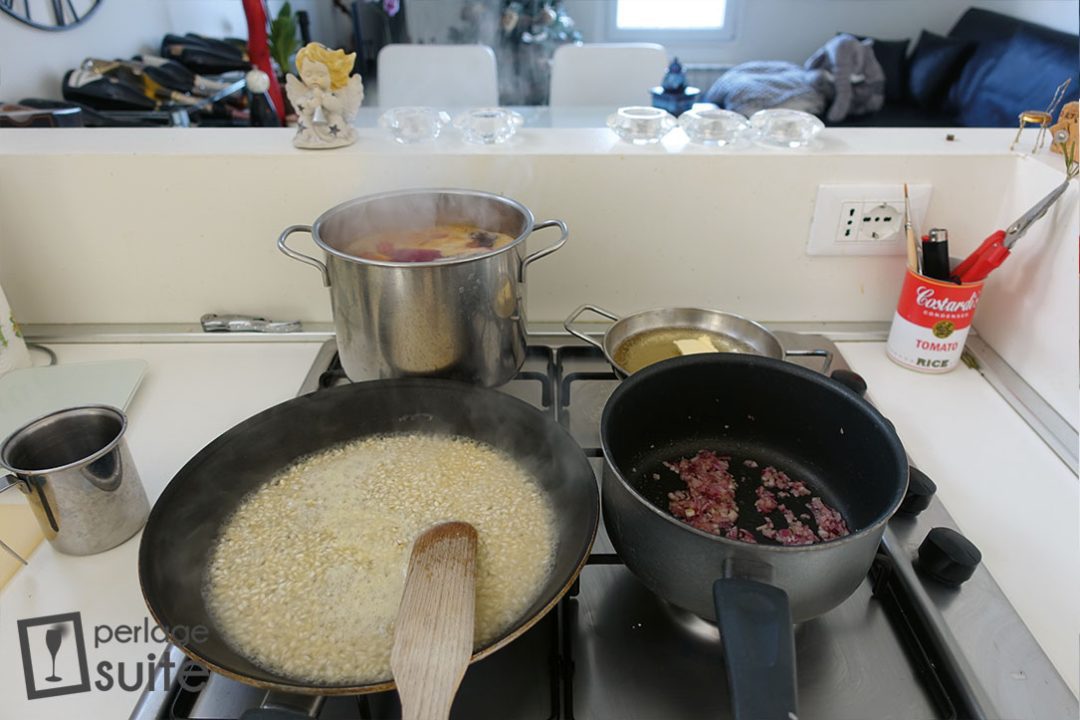
Add the sautéed onion and deglaze with 100 ml Champagne. Start adding the previously prepared boiling stock one ladleful at a time and let it dry (not stick!) before adding the next ladleful. Gently stir between ladlefuls of stock with a wooden spoon. Let the remaining butter melt in the remaining Champagne at room temperature. When the rice is almost cooked, turn the pan containing the butter and Champagne on very low heat and melt the butter. Emulsify with a whisk.

Taste the risotto: it must be cooked, not mush. When it is cooked, turn off the heat, remove it from the large cooker and move it to the small cooker on a low heat. To avoid letting it dry out too much, move the risotto to the small pan where you sautéed the butter. The fabulous Chef inside you will tell you not to turn on the cooker, but the fact of the matter is that for a perfect homemade mantecatura a light heat helps. Add the Parmesan cheese and the mantecatura liquid composed of butter and Champagne and whisk quickly until it has a creamy consistency.
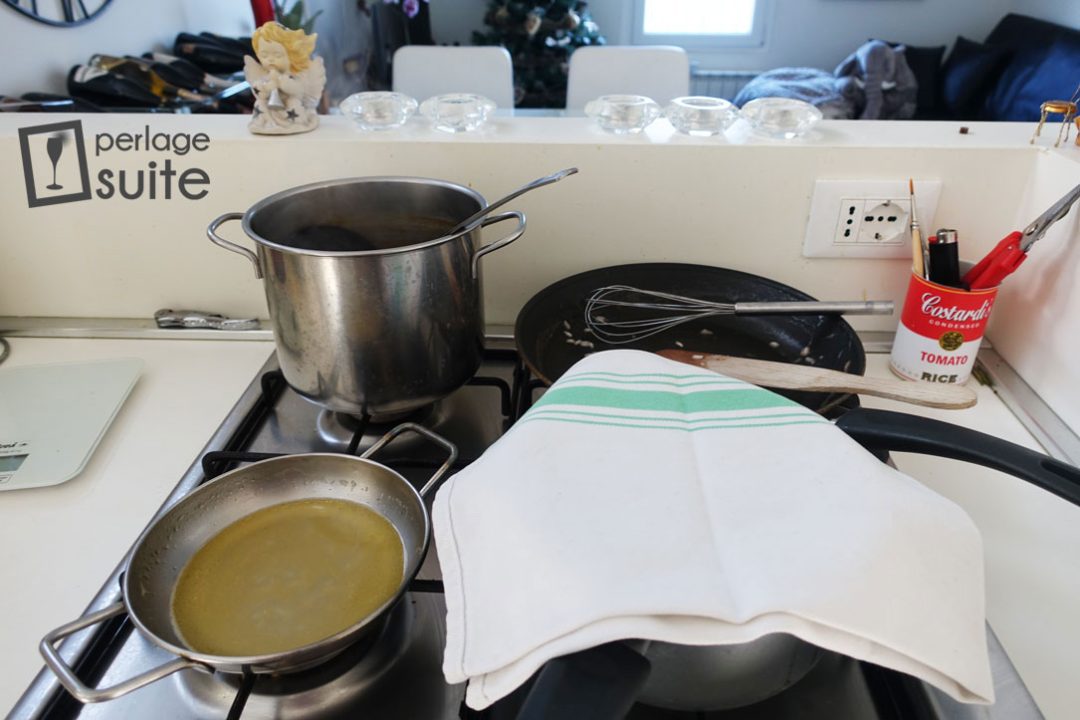
Cover the risotto for 2 minutes with a clean tea towel.... just long enough to open the two oysters wishing you were faster than me! Mash the oyster liquid with the risotto in the pan until it is absorbed.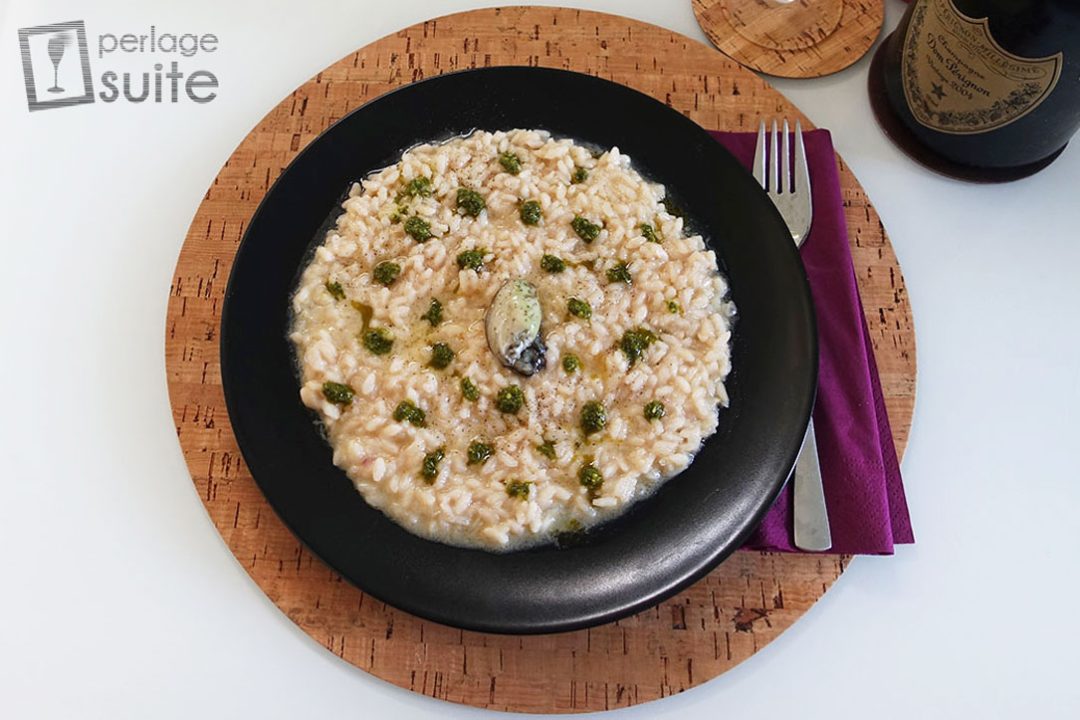
Serve by placing two ladles of Risotto on a black plate to create a nice contrast. Smack the plate with the palm of your hand to spread the risotto on the plate, which should be wavy. Add a few drops of pesto (you can use the leftover pesto to make spaghetti tomorrow) and place the raw oyster in the centre.
Sprinkle with pepper and enjoy. Obviously paired with the same Champagne or Spumante Metodo Classico that you used to prepare the Risotto. You will see, it will be perfect: the bubbles will degrease the abundant butter and its flavour together with that of the pesto will contrast the sweetness of the oyster. Now all you have to do is choose your favourite Champagne and prepare this delicious risotto for the person you love!
Try making this recipe and let me know in a comment if you like it... I find it one of the best risottos of my life! 😍
Happy New Year 😌... and be sure to go on a diet from next Monday! 😅
Cheers 🍷
Chiara

